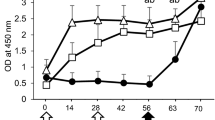Abstract
THE distribution with age of antibodies against human and animal influenza viruses in man seems to be increasingly important in the interpretation of the epidemiology of influenza A. Findings with the recently isolated equine influenza A virus suggest that this virus has been responsible for the influenza epidemics near the beginning of this century1, about 10 yr after the 1889–1890 influenza pandemic, which was probably caused by the influenza A2 virus2.
Similar content being viewed by others
References
Masurel, N., and Mulder, J., Bull. WHO, 34, 885 (1966).
Mulder, J., and Masurel, N., Lancet, i, 810 (1958).
Marois, P., Pavilanis, V., Boudreault, A., and DiFranco, E., Canad. J. Comp. Med., 27, 257 (1963).
Kasel, J. A., Alford, R. H., Knight, V., Waddell, G. H., and Sigel, M. M., Nature, 206, 41 (1965).
Author information
Authors and Affiliations
Rights and permissions
About this article
Cite this article
MASUREL, N. Antibody Response obtained by Vaccination with the Influenza A/Equi 2 Virus in Man. Nature 218, 100–101 (1968). https://doi.org/10.1038/218100a0
Received:
Issue Date:
DOI: https://doi.org/10.1038/218100a0
- Springer Nature Limited
This article is cited by
-
Antigenic relationships between avian paramyxoviruses
Archives of Virology (1988)





